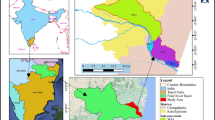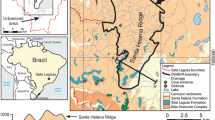Abstract
Modelling of ground water recharge-potential in hard-rock areas principally aims at water-resource evaluation. Various techniques are available to assess recharge-potential, and their capability in estimating recharge is also variable. However, the water level fluctuation method is found capable in computing actual ground water recharge. Demarcation of ground water recharge-potential zones in arid and semi-arid regions is of great importance for human survival and sustainable development. Remote sensing and geographic information systems (GIS) techniques have been widely used by numerous researchers for qualitative assessment of ground water potential of a basin or terrain. In the present study, a GIS-based water table fluctuation method has been attempted for quantitative modelling of ground water recharge of the hard-rock Aravalli terrain. This GIS-based model is further used to evaluate recharge-potential of the terrain by integrated assessment of infiltration capacity, normal rainfall, and its cumulative frequency.







Similar content being viewed by others
References
Al-abed N, Abdulla F, Khyarah AA (2005) GIS hydrological models for managing water resources in the Zarqa river basin. Environ Geol 47:405–411
Al-Saafin AK, Bader TA, Shehata W (1990) Ground water recharge in an arid karst area in Saudi Arabia. In: Simpson ES, Sharp JM Jr (eds) Selected papers on hydrogeology, vol 1. IAH/Verlag Heinz Heise, Hanover, pp 29–41
Anbazhagan S, Ramasamy SM, Dasgupta S (2005) Remote sensing and GIS for artificial recharge study, runoff estimation and planning in Ayyar basin, Tamil Nadu, India. Environ Geol 48:158–170
Arnold JG, Muttiah RS, Srinivasan R, Allen PM (2000) Regional estimation of base flow and ground water recharge in the Upper Mississippi River Basin. J Hydrol 227:21–40
Athavale RN, Rangarajan R (1988) Natural recharge measurements in the hard-rock regions of semi-arid India using tritium injection—a review. In: Simmers I (ed) Estimation of natural ground water recharge. Reidel, Dordrecht, pp 175–195
Central Ground Water Board (CGWB) (1997) Ground water resources of India. Central Ground Water Board, India
Champatiray PK, Roy AK, Dave V (1993) GIS and RS for ground water investigation in Manbazar-II. ISRS National Symposium, Guwahati, pp 180–184
Chi KH, Lee BJ (1994) Extracting potential ground water area using remotely sensed data and GIS techniques. In: Proceeding of the regional seminar on integrated applications of remote sensing and GIS for land and water resources management, Bangkok (Bangkok: Economic and Social Commission for Asia and the Pacific), pp 64–69
Constanz J, Thomas CL, Zellweger G (1994) Influence of diurnal variations in stream temperature on streamflow loss and ground water recharge. Water Resour Res 30:3253–3264
Cook PG, Jolly ID, Leaney FW, Walker GR (1994) Unsaturated zone tritium and chlorine 36 profiles from southern Australia: their use as tracers of soil water movement. Water Resour Res 30:1709–1719
Crosbie RS, Binning P, Kalma JD (2005) A time series approach to inferring ground water recharge using the water table fluctuation method. Water Resour Res 41: W01008, doi:10.1029/2004WR003077
Department of Science, Technology (DST) (1994) Resource atlas of Rajasthan. Government of Rajasthan, Jaipur
Edet AE, Okereke CS (1997) Assessment of hydrogeological conditions in basement aquifers of the Precambrian Oban massif. southeastern Nigeria. J Appl Geophys 36:195–204
El-kadi AI, Oloufa AA, Eltahan AA, Malik HU (1994) Use of a geographic information system in site-specific ground water modelling. Ground Water 32:617–625
Eriksson E, Khunakasem V (1969) Chloride concentration in ground water, recharge rate and rate of deposition of chloride in the Israel Coastal Plain. J Hydrol 7:178–197
Ezzedine S, Rubin Y, Chen J (1999) Bayesian method for hydrogeological site characterization using borehole and geophysical survey data: theory and application to the Lawrence Livermore National Laboratory Superfund site. Water Resour Res 35:2671–2683
Flint AL, Flint LE, Kwicklis EM, Fabryka-martin JT, Bodvarsson GS (2002) Estimating recharge at Yucca Mountain, Nevada, USA: comparison of methods. Hydrogeol J. doi:10.1007/s10040-001-0169-1
Finch JW (1998) Estimating direct ground water recharge using a simple water balance model—sensitivity to land surface parameters. J Hydrol 211:112–125
Geological Survey of India (GSI) (1995a) Lithological map of the Pre-Cambrians of the Aravalli region: Southern Rajasthan and North-eastern Gujarat, India (1:250,000 scale)
Geological Survey of India (GSI) (1995b) Structural geological map of the Pre-Cambrians of the Aravalli Region: Southern Rajasthan and North-eastern Gujarat, India (1:250,000 scale)
Gustafsson P (1993) High resolution satellite data and GIS as a tool for assessment of ground water potential of a semi-arid area. IXth Thematic Conference on Geologic Remote Sensing, Pasadena, California, USA (8–11 February 1993), 1, pp 609–619
Hall DW, Risser DW (1993) Effects of agricultural nutrient management on nitrogen fate and transport in Lancaster county Pennsylvania. Water Resour Bull 29:55–76
Healy RW, Cook PG (2002) Using ground water levels to estimate recharge. Hydrogeol J 10:91–109
Houston J (2004) High-resolution sequence stratigraphy as a tool in hydrogeological exploration in the Atacama Desert. Q J Eng Geol Hydrogeol 37:7–17
Jaiswal RK, Mukherjee S, Krishnamurthy J, Saxena R (2003) Role of remote sensing and GIS techniques for generation of ground water prospect zones towards rural development—an approach. Int J Remote Sens 24:993–1008
Jyrkama MI, Sykes JF, Normani SD (2002) Recharge estimation for transient ground water modelling. Ground water 40:638–648
Kendy E, Gérard-marchant P, Walter MT, Zhang Y, Liu C, Steenhuis TS (2003) A soil-water-balance approach to quantify ground water recharge from irrigated cropland in the North China plain. Hydrol Process 17:2011–2031
Khair K, Haddad F (1993) The fractured carbonate rocks of Lebanon and their seasonal springs. In: Hydrogeology of hard rocks, Memoirs of 24th Congress of IAH, Oslo, Part 2, pp 1135–1144
Krishnamurthy J, Srinivas G (1995) Role of geological and geomorphological factors in ground water exploration: a study using IRS LISS data. Int J Remote Sens 16:2595–2618
Krishnamurthy J, Manavalan P, Saivasan V (1992) Application of digital enhancement techniques for ground water exploration in a hard rock terrain. Int J Remote Sens 13:2925–2942
Krishnamurthy J, Venkatesa Kumar N, Jayaraman V, Manivel M (1996) An approach to demarcate ground water potential zones through remote sensing and a geographic information system. Int J Remote Sens 17:1867–1884
Lapham WW (1989) Use of temperature profiles beneath streams to determine rates of vertical ground water flow and vertical hydraulic conductivity. US Geol Surv Water Supply Paper, pp 2337–2372
Leavesley GH, Stannard LG (1995) The precipitation—runoff modeling system—PRMS. In: Singh VP (ed) Computer models of watershed hydrology. Water Resources Publications, Colorado, pp 281–310
Mabee SB, Curry PJ, Hardcastle KC (2002) Correlation of lineaments to ground water inflows in a bedrock tunnel. Ground Water 40:37–43
Majumdar RK, Pal SK (2005) Geoelectric and borehole lithology studies for ground water investigation in alluvial aquifers of Munger district. Bihar. J Geological Soc India 66:463–474
Meijerink AMJ, de Brouwer HAM, Mannaerts CM, Valenzuela CR (1994) Introduction to the use of Geographic Information Systems for practical hydrology, UNESCO International Hydrological Programme, ITC Publication No. 23
Pal SK, Majumdar RK (2001) Determination of ground water potential zones using iso-resistivity maps in alluvial areas of Munger district, Bihar. Ind J Earth Sci 1–4:16–26
Philips FM, Mattick JL, Duval TA (1988) Chlorine 36 and tritium from nuclear weapons fallout as tracers for long-term liquid movement in desert soils. Water Resour Res 24:1877–1891
Prudic DE (1994) Estimates of percolation rates and ages of water in unsaturated sediments at two Mojave Desert sites, California–Nevada. US Geol Surv Paper 94:4079–4160
Raj S, Sinha AK (1989) An integral approach for the delineation of potential ground water zones using satellite data: case study, Udaipur District, Rajasthan. Asia-Pacific Remote Sens J 2:61–64
Rangarajan R, Athavale RN (2000) Annual replenishable ground water potential of India—an estimate based on injected tritium studies. J Hydrol 234:38–53
Ronan AD, Prudic DE, Thodal CE, Constantz J (1998) Field study and simulation of diurnal temperature effects on infiltration and variably saturated flow beneath an ephemeral stream. Water Resour Res 34:2137–2153
Salama RB, Battle GA, Farrington P, Wilson V (1994) Basin geomorphological controls on the mechanism of recharge and discharge and its effect on salt storage and mobilisation—comparative study using geophysical surveys. J Hydrol 155:1–26
Saraf AK, Choudhury PR (1998) Integrated remote sensing and GIS for ground water exploration and identification of artificial recharge sites. Int J Remote Sens 19:1825–1841
Saraf AK, Jain SK (1993) Integrated use of remote sensing and GIS methods for ground water exploration in parts of Lalitpur District, UP International Conference on Hydrology and Water Resources, New Delhi, 20–22 December 1993
Saraf AK, Choudhury PR, Roy B, Sarma B, Vijay S, Choudhury S (2004) GIS based surface hydrological modelling in identification of ground water recharge zones. Int J Remote Sens 25:5759–5770
Scanlon BR (1992) Evaluation of liquid and vapor flow in desert soils based on chlorine-36 and tritium tracers and nonisothermal flow simulations. Water Resour Res 28:285–297
Scanlon BR (2002) Uncertainties in estimating water fluxes and residence times using environmental tracers in an arid unsaturated zone. Water Resour Res 36:395–409
Sen PK (2002) An Introduction to the Geomorphology of India. Allied Publishers, New Delhi
Shahid S, Nath SK (2000) GIS integration of remote sensing and electrical sounding data for hydrogeological exploration. J Spatial Hydrol 2:1–12
Shahid S, Nath SK, Roy J (2000) Ground water potential modelling in a soft rock area using a GIS. Int J Remote Sens 21:1919–1924
Sharma ML (1989) Ground water recharge. AA Balkema, Rotterdam
Singhal BBS, Gupta RP (2001) Applied hydrogeology of fractured rocks. Kluwer, Dordrecht
Sophocleous M (1985) The role of specific yield in ground water recharge estimations: a numerical study. Ground Water 23:52–58
Sophocleous M (1991) Combining the soil water balance and water-level fluctuation methods to estimate natural ground water recharge: practical aspects. J Hydrol 124:229–241
Stallman RW (1964) Multiphase fluid flow in porous media–a review of theories pertinent to hydrology studies. US Geol Surv Professional Paper, 411–E:51
Stewart M, Layton M, Lizanec T (1983) Application of resistivity surveys to regional hydrologic reconnaissance. Ground Water 21:42–48
Sukhija BS, Reddy DV, Nagabhusshanam P, Chand R (1988) Validity of the environmental chloride method for recharge evaluation of coastal aquifers. J Hydrol 99:349–366
Walker GR, Zhang L, Ellis TW, Hatton TJ, Petheram C (2002) Towards a predictive framework for estimating recharge under different land uses: review of modeling and other approaches. Hydrogeol J. doi:10.1001/s10040010181–5
Acknowledgments
The authors take this opportunity to express their sincere thanks to Dr. S. M. Pandey, ex-chief geophysicist of Ground Water Department, Jodhpur, Rajasthan, for his generous help during collection of hydrological and meteorological data. A part of this work was carried out by the first author at FSU Jena, Germany through the DAAD (German Academic Exchange Service) Fellowship. We are grateful to the anonymous Reviewer for his comments/suggestions. The authors are grateful to Dr. Menas Kafatos for his editorial corrections and suggestions.
Author information
Authors and Affiliations
Corresponding author
Rights and permissions
About this article
Cite this article
Bhuiyan, C., Singh, R.P. & Flügel, W.A. Modelling of ground water recharge-potential in the hard-rock Aravalli terrain, India: a GIS approach. Environ Earth Sci 59, 929–938 (2009). https://doi.org/10.1007/s12665-009-0087-4
Received:
Accepted:
Published:
Issue Date:
DOI: https://doi.org/10.1007/s12665-009-0087-4




